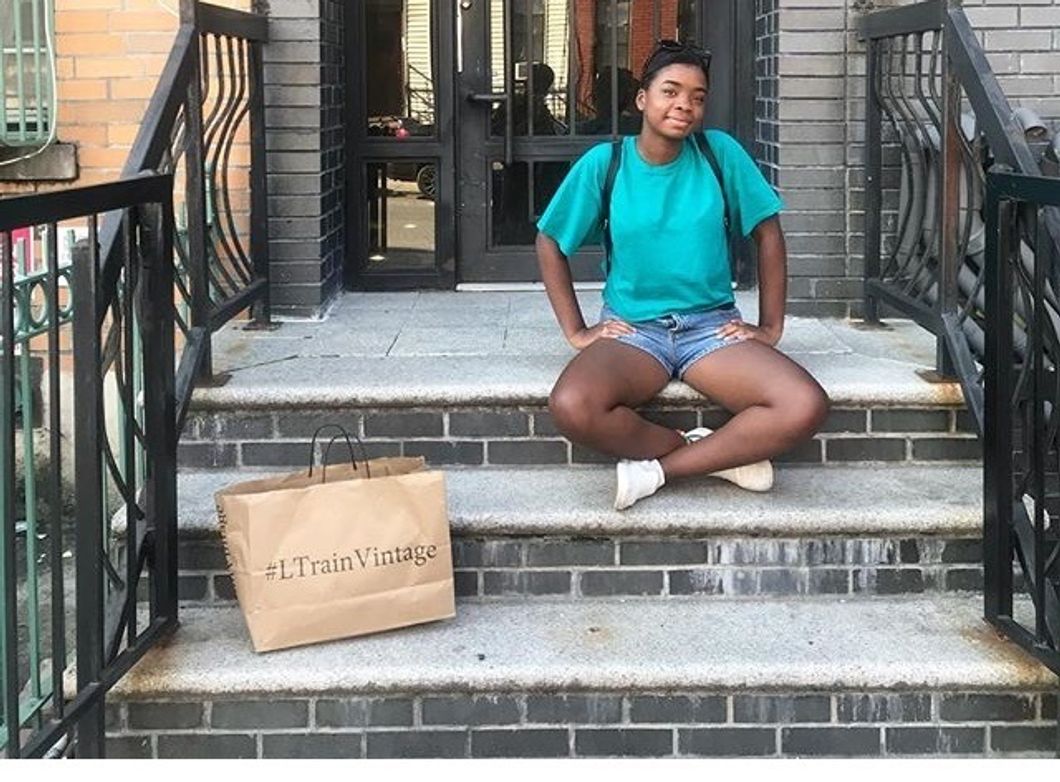It's an arid August night and I am wandering around a cramped Bed Stuy apartment. Everyone else is entranced by the abstract or political pieces of art on the walls, the distorted Pocahontas movie screening by the projector, or the gentle ambiance of the setting including an affectionate grey kitten. While all of this occurs at once, my eyes still cannot help but shift from the art on the walls to the artful outfits sported by the other party-goers.
The phenomenon hitting our generation is the distinct desire to stand apart from the crowd with our clothing rather than to conform as it was previously. Suddenly it became cool to say your entire vintage outfit cost a whopping $10 from L Train (or your city's equivalent thrift shop). Looking at the fashion of each generation, we can observe both a normative trend of clothing and a much smaller group of countercultural trends. Not to say that teenagers and twenty-year-olds are not still frequenting Forever 21, H&M, and other corporate companies; however, even the approach to such stores has changed from finding a style shirt that everyone has or that Vogue claims is in season, rather to look for the more unique pieces that one might as easily assume were thrifted.
Backtrack to 2013...
I roll out of bed and into a pair of athletic shorts, my grey plaid skirt, maroon polo, then slide into my Birkenstocks on my way out the door. I repeat this routine Monday through Friday, freshman through senior year of high school. When people asked how I felt about uniforms, I would consistently respond "I love them because I don't have to take time choosing something to wear." While this statement was truthful, it meant I barely shopped throughout high school then suddenly I was expected to have a wardrobe that would account for seven days a week, 365 days a year, for the rest of my life.
Buying this new set of clothing before college was a trainwreck, to put it kindly. It was a blur of buying the same v-neck in three different colors from Forever 21, ill-fitting jeans from H&M, unflattering crop tops from Urban Outfitters, and repeat ten times over. It was not until about halfway through my freshman year that I realized how telling an outfit can be about someone's personality and mine was screaming insecure plain jane. I recognized the problem with my clothing is that all the moving parts to it essentially had the same role, to be very malleable or in more frequently used terms "could go with anything."
The problem with wearing an entire outfit of pieces that "can go with anything" is you end up missing out on the art form of fashion or the chance to express your personality through style. See, when I paint I would not create a scene using all neutral colors. I would more likely than not use neutral colors for the background or scenery and then choose a vibrant color for my focal point of the picture. As soon as this realization came to me, I could not help but observe everyone's outfits on the subway, in class, in the park, or simply walking down the street and to my unsurprising contentment, a pattern appeared. People were like walking paintings choosing a piece to act as the focal point of the outfit, matching the other pieces to aesthetically accommodate the centerpiece and further embellishing with personal flair, granted some people's personal flare consists of making the entirety of pieces in their outfit the focal point and these people may or may not have walked straight off the runway of New York Fashion Week.
This important distinction in artfully crafting outfits has further motivated the desire to thrift because often the clothing found is singular and draws our attention standing on its own, typically with no other similar piece in sight. The uniqueness and often improved quality of such items persuade us to fill shopping bags of individual pieces to be further inspiration for our wardrobe.
Fast fashion is out, the art of fashion is in.
There are those party shirts you spend $3 on knowing full well you will wear maybe twice before they are stained or broken and that is perfectly satisfying. However, people my age are increasingly frustrated by an entire wardrobe consisting of such cheap fabrics or poorly designed clothing. This is something it seems my mom and other members of generations older than my own, have long-ago figured out: quality over quantity.
Finally, I am recognizing the value in spending a little extra money on a centerpiece item that fuses fashion and durability. The greatest part of thrift is often this does not even require a monetary sacrifice because most of the pieces would not have survived as long as they had, in their current condition, if they were not made to last. Also, this is highly applicable to stable wardrobe pieces such as a jean jacket, a belt, a pair of sunglasses, or any item you might not go out without.
Thrifting accommodates our creative whims.
If I know a shirt cost me $4 then I am less inclined to be nervous about cutting it, making it into a tank, crop, or tube top, giving it a v-neck lining, or purposefully layering in some string, lace, additional fabric to give it a flair. Rather than forcing ourselves to conform to the piece, we are given the freedom to make the piece our own, to reflect our style, and to shape it how it best flatters our bodies. I constantly fear that I accidentally shrunk my expensive BDG Jeans in the dryer; meanwhile, I will happily attack a pair of $15 thrifted Levi jeans with scissors, fraying the ends or repurposing them into cutoff shorts. There is a strong sense of personal satisfaction in creating a piece to suit your preferences, especially if it turns out better than you hoped.
I find myself sometimes hesitating if someone asks where my pants are from if my truthful response is Urban Outfitters.
It's rooted in this generation's more distinct association with understanding the origins of the products they choose to buy and higher ethical standards for companies, particularly those like Urban Outfitters and Nike who are notoriously known to utilize sweatshop labor. People are ditching the digs made at the hands of underpaid laborers and demanding higher ethical standards.
Not only is it popular now to pay your laborers fairly and treat them with dignity, but it is also highly appealing to buy from a company with a story, a mission statement that strikes a chord. Such companies include Toms, BANGS Shoes, Sevenly, Serengetee, and Article 22 to name a few. These places make the shopping experience one that allows you to benefit more than just yourself and the company, but an external cause as well. Along these same guidelines, it is common to see more and more non-vegans, such as myself, looking to buy vegan leather Dr. Martens, non-suede Vans, or faux-leather and faux-fur jackets. I know for me this is only a recent development in my fashion conscience as I have owned yellow suede Vans, green suede Dr. Martens, and thrifted a jean jacket with a real leather lining; however, the reason I have decided to shop vegan from here on out is I do not take issue with using meat as a substantive source of protein in my diet, but to take an animal's life, or in most cases several animals' lives, for the sake of a single clothing piece is a bit heart-wrenching.
Similarly, on the rare occasion I buy makeup, it is from Fenty Beauty and PUR Cosmetics both of which are cruelty-free brands, therefore no testing of animals was used in the production of that product. Why hurt an animal unnecessarily when there are great vegan pieces to sport and cruelty-free brands.
Thrift has made it the World Wide Web.
Among the aforementioned reasons why ethical thrift is the new black, I did not include arguably one of the most appealing aspects of this modern age: online thrifting. Poshmark, thredUP, Etsy, Tradesy, Depop, and the list goes on. Although I would personally rather go to L Train than shop online, this preference is not necessarily a popular one when paired with the schedule of a college student or a working twenty-something. All the same rules apply but without the hours spent physically sifting through clothing pieces because the organization of these sites makes it easy to pinpoint the items and styles you want to peruse. Lastly, online thrift sites are twofold allowing you to efficiently sell off those pieces in your closet that have overstayed their welcome with the assurance that they will be appreciated by another individual and without losing out on the investment.
Essentially if you have stuck to shopping at the same three mainstream stores or you're simply bored with your wardrobe, I would recommend taking an excursion to your local thrift shop. There are nearly three thousand Goodwill stores in the United States alone, so you are bound to be near one. While you are at it, do a quick Google search on the ethical policies of the brand before you buy. It's a small way you can contribute to the greater good of the environment and the welfare of other humans.






















